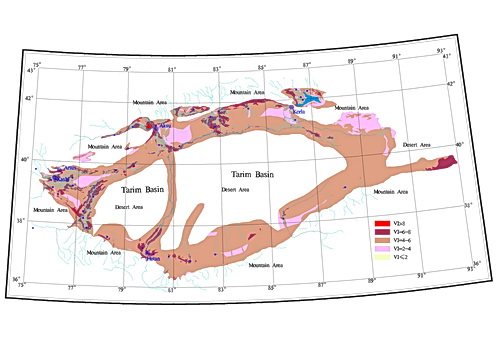Highlight 2010-003Update time:06 11, 2010
Fig.Sketch map of vulnerability of phreatic water in Tarim Basin Study of groundwater vulnerability is of great significance in protecting groundwater environment and ensuring sustainable groundwater utilization. Recently, Prof. Jinlong Zhou and Guomin Li and other colleagues proposed DRAV model for groundwater vulnerability assessment according to the characteristics of groundwater in arid area, where D is groundwater depth, R is the net recharge of aquifer, A is the aquifer characteristics, and V is the lithology of vadose zone. As a case study, they assessed the vulnerability of pore phreatic water in Tarim Basin of Xinjiang, China by using the DRAV model. The results indicate that the areas of phreatic water with vulnerability index ranges of 2–4, 4–6, 6–8 and 8 accounting for 10.1%, 80.4%, 9.2% and 0.2% of the total plain area of the Tarim Basin respectively, and the areas with the latter two vulnerability ranges (6–8 and 8) are mainly located in the irrigation districts with thin soil layer (20–30 cm thick surface soil of vadose zone, mainly with underlying sandy gravel) and with silty and fine sand layer. Such vadose zone generally lacks sandy loam and clayey soil and has larger recharge by infiltration of irrigation water. This study was published in Environmental Earth Sciences(Zhou et al. DRAV model and its application in assessing groundwater vulnerability in arid area: a case study of pore phreatic water in Tarim Basin, Xinjiang, Northwest China. Environmental Earth Sciences, 2010, 60: 1055-1063).
|
Contact
Related Articles
Reference
|
-
SIMSSecondary Ion Mass Spectrometer Laboratory
-
MC-ICPMSMultiple-collector ICPMS Laboratory
-
EM & TEMElectron Microprobe and Transmission Electron Microscope Laboratory
-
SISolid Isotope Laboratory
-
StIStable Isotope Laboratory
-
RMPARock-Mineral Preparation and Analysis
-
AAH40Ar/39Ar & (U-Th)/He Laboratory
-
EMLElectron Microscopy Laboratory
-
USCLUranium Series Chronology Laboratory
-
SASeismic Array Laboratory
-
SEELaboratory of Space Environment Exploration Laboratory
-
PGPaleomagnetism and Geochronology Laboratory
-
BioMNSFrance-China Bio-mineralization and Nano-structure Laboratory

 Print
Print Close
Close
